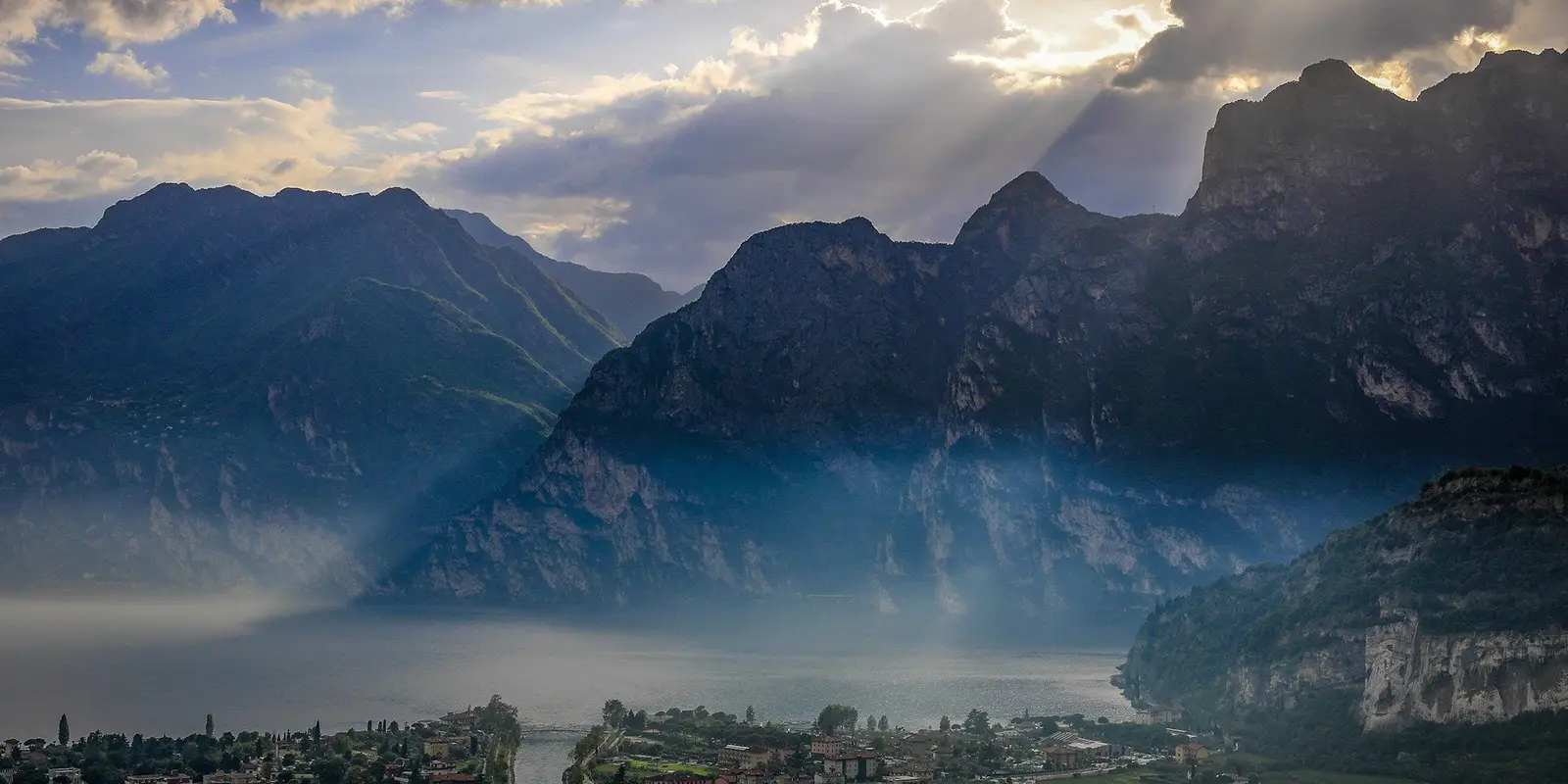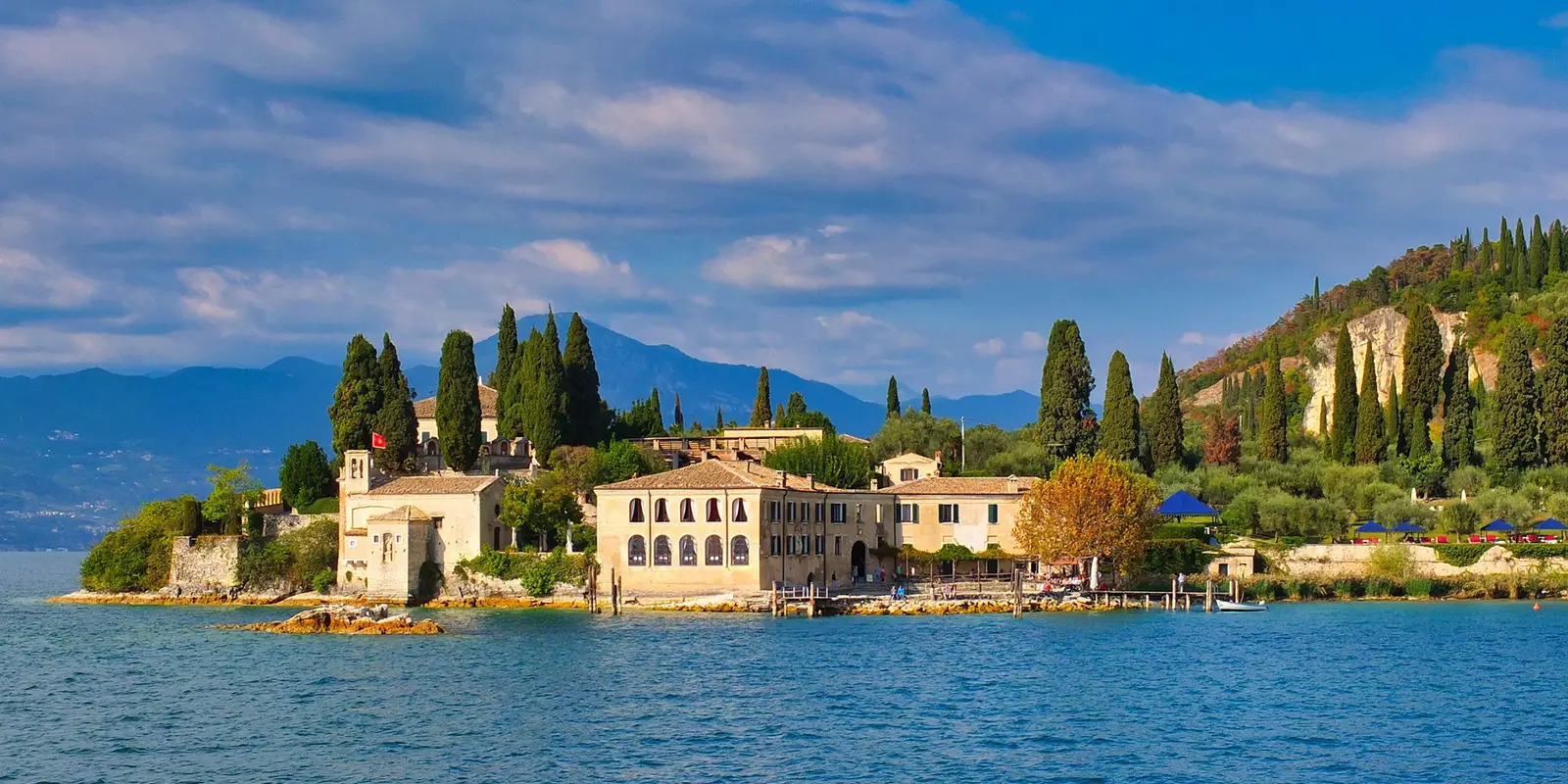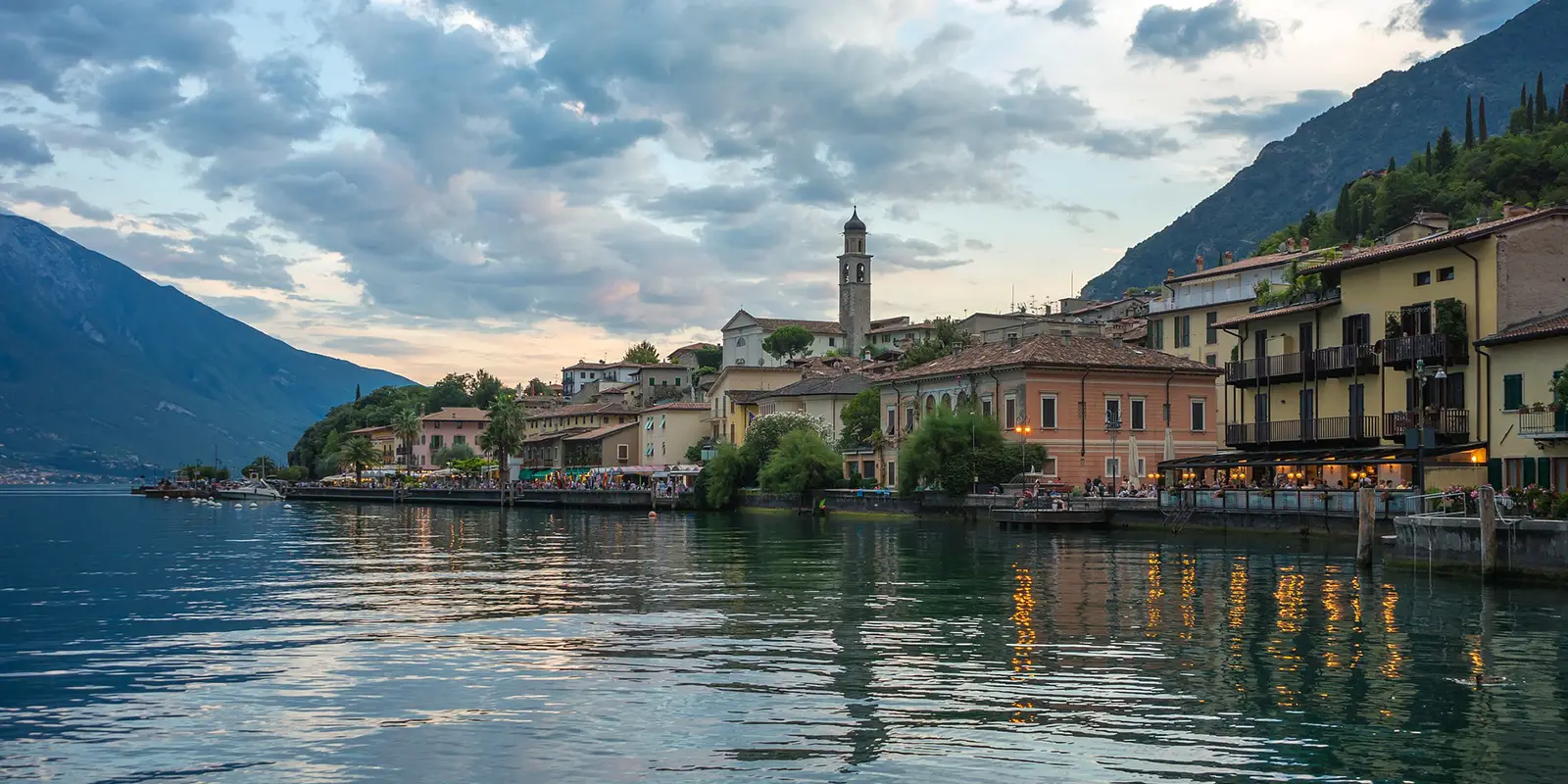Lago di Garda (Lake Garda) is Italy’s largest lake. It derives its name from the Germanic word warda, meaning “place of guard” or “place of observation”. Its serenity, unique villages and towns, and northern mountains make it Northern Italy’s most popular tourist destination.
Italians are famous for architecture, cuisine, and fashion, and Lake Garda rises high in that respect with beauty, culture, and history. It offers resorts, castles, restaurants, and amazing wedding venues. It lies in the Regions of Lombardy, Trentino Alto Adige, and Veneto (Italian regions are like states/provinces).
What Lake Garda Is Known For
Lake Garda is 32-miles long (52 meters) with an average depth of 446 feet (136 meters) and a maximum depth of 1135 feet (346 meters). It covers a surface area of 91,420 acres (370 square meters). Lake Garda sports a balmy Mediterranean climate.
Lake Garda’s widest area is its southern pool, where flat landscapes meet its shores. The lake narrows in most of its length in its northern arm, as it grows from the plain in the middle to the Dolomite Mountains rolling down to the shorelines. From Sirmione, the most popular southern Lake Garda town, to Riva del Garda on its northern tip, olive oil producers from large to small press their golden oils.
Lake Garda’s history involves centuries of superpowers clashing in bloody wars for conquest of the lake. The meetings of those cultures culminate in the Lake Garda village’s unique characters. Its northern region reflects a Central European heritage, and its southern area sticks closer to Italian traditions.
Prehistoric people inhabited the Lake Garda region, known as the territory of Brescia, when the Pliocene Sea covered it. The lake is also known as Lake Benaco, from when the classical writers Virgil, Horace, and Catullus referred to the lake as Lacus Benacus.
Eighteen mountain peaks tower up to 9,842 miles, known as the Dolomites of the Italian Alps. People regard the Dolomites as among the most picturesque and attractive mountain landscapes on earth. Northern Lake Garda and the Dolomites are popular Italian holiday destinations.
Lake Garda Weather and Climate
The Mediterranean-like climate is wonderful year round at Lake Garda with December and January temperatures rarely falling below 30 °F (-1 °C) at night. Summer is the busiest time of year in the region. Winds sweeping across the lake provide for exciting sailing and windsurfing.
The mean temperature year-round at Lake Garda is 51 °F (10.5 °C) minimum and 65 °F (18 °C) maximum. From March to June, maximum temps run from 57 °F (14) to 81 °F (27). July and August temperatures can go up to 85 °F (29.5 °C) or a little more. From September to January, maximums start at 75 °F (24 °C) and go down to 47 °F (8 °C).
Intense winds zoom across Lake Garda from all directions. The Italians have named their winds. Where Lake Garda’s southern pool meets its northern arm, it creates a wind bottleneck, which affects the timing of wind activity on the lake. Winds flow down from the Dolomites in the morning and swirl back up them in the afternoon.
The two major winds are “Pelér”, a boy, and “Ora”, a girl, and their accompanying secondary winds are “Balì” or “Balinot” and “Vinessa”. The tertiary winds are “Bora”, “Ander”, and “Gardesana”. Pelér blows from north to south in the morning. The sun warms up Ora. She blows back up to the Dolomites in the afternoon, which pushes cool air up into the mountains to become tomorrow’s Pelér.

Five Islands Emerge Out of Lake Garda
Isola del Sogno (Island of Dreams) is only 20 meters off the coast near Malcesine, Veneto, on the eastern border. When the lake water level is low, people walk to Isola del Sogno. Scuba divers populate the island to dive to the 52.5-feet-long (16-meter), 1987 wreck of an iron cruise ship. This ship is anchored to the shore. Scuba lovers also have other sunken ships to explore in Lake Garda.
Isola dell’Olivo (Island of Olive Trees) is home to the annual “Centomiglia” sailing regatta in September. It is also popular with scuba divers for a small cave full of plants and a 33-foot-long (10-meter) wreck that houses different species of fish.
Isola di Trimelone is right off the shores of Assenza di Brenzone, on the eastern edge of Lake Garda. Before World War I, this island was an outpost for its strategic position at the border with the Austro-Hungarian Empire. It became a war dump after WWII and was left with explosives and weapons around the island. An explosion destroyed half of the island in October 1954. Access to this island is restricted due to the remaining danger.
San Biagio Island/Isola dei Conigli (Island of Rabbits) is close to Manerba Porto Torchio on the eastern shore. Its abundant wild rabbits are almost tame. People can reach it on foot in the summer, or by water-taxi anytime. It is free to visit for guests of camping San Biagio and charges a fee to others. “Scoglio dell’Altare”, a rock 492-feet (150-meters) underwater, is famous with scuba divers for yellow sponge balconies and a cave where large common bleaks, eels, perches, pikes, and tenches hang out.
Isola del Garda/Borghese Island (Island of Garda) is Lake Garda’s largest island near San Felice del Benaco on the eastern shore. It is privately owned by Lady Charlotte Cavazza. She lives on the island with her family of seven children, four brothers, three sisters, and their families. Visitors must book their visits to this island through an authorized guide.
Isola del Garda is home to the Giardino dell’Isola del Garda, a luxurious garden park rich in exotic and native plants featuring a forest with pines, cypresses, lemon trees, agaves, and magnolias and other flowers. Its tour lasts a few hours and includes wine and olive oil tasting and a tour of Lady Charlotte’s villa. Small dogs are welcome for an extra fee. The island hosts musical events from April to October.

Things to Do at Lake Garda
There are hundreds of things to do and places to see at Lake Garda that attract families and people who are kid-free. Of the 26 towns and villages around Lake Garda with beaches and lake activities, ferries, and boat tours, campgrounds, the Dolomites, Desenzano, Manerba del Garda, Riva del Garda, Salò, and Sirmione are the best known.
Visitors can reach Lake Garda from anywhere in Northern Italy. It takes a little over an hour from Milan and Venice, and about half an hour from Verona to get to parts of Lake Garda, if visitors want to include a day trip. Other popular villages are Bardolino, Lazise, Limone sul Garda, Malcesine, Peschiera del Garda.
Desenzano is Lake Garda’s largest town known for its shopping and the nightlife. Its transport links make it easy to go all over Italy. It offers three large beaches, Desenzanino Beach, Porto Rivoltella Beach, and Spiagga d’Oro, where you can rent sunbeds and pedalos. Its lakefront gives fantastic views up the lake to the Dolomites and is full of bars, cafés, and gelateries.
Desenzano’s historic town center’s central point is Porto Vecchio and lined with restaurants and bars that continue into the open piazzas. This area was home to wealthy Romans in the 1st and 2nd centuries. Desenzano is bustling most of the time because it is popular with Italians from other towns.
Manerba del Garda on the western shoreline of Lake Garda lies in the heart of the Valtenesi, a lush green area with 67 types of soils of glacial origin that creates a unique biodiversity, and is famous for premium wines.
Five communities above Manerba, Balbiana, Montinelle, Pieve e Gardoncino, and Solarolo are scattered on surrounding hills full of vineyards and olive groves near the beautiful Parco della Rocca di Manerba.
Popular attractions are Porto Vecchio and the Todeschini Palace, the Castello di Desenzano, an 11th century castle, Museo Civico Archeologico Giovanni Rambotti, which displays prehistoric and Bronze age artifacts, Duomo di Santa Maria Maddalena, a 16th century cathedral, and Villa Romana Antiquarium, an excavated Roman villa.
Riva del Garda in the far north in the shadow of the Dolomites features two harbors in a motorboat-free zone and is popular for windsurfing, kiting, and sailing with outfitters and lessons. La Rocca, a medieval fortress, dominates this town and is the home of the Civic museum.
Other places to visit are Torre Apponale, a 13th century tower, Bastione di Riva del Garda, a 16th century fortress, Parco Grotto Cascata Varone, a waterfall, and Chiesa Santa Maria Assunta, a 1728 Italian Baroque church.
Riva del Garda is a popular destination for rock climbing, mountain biking and hiking. The Old Ponale trail leads up the Monte di Riva to the Ponale river and its beautiful waterfall. Do not forget the fantastic restaurants.
Salò sits on the bay of Golfo di Salò, under the steep, forested hills of St Bartolomeo. Salò boasts the longest lungolago (promenade) on Lake Garda. Beginning at the historic center, the lungolago runs past the marina and around the bay to a beautiful beach. A footpath leads to Portese. Dine alfresco at Salò’s many pizzerias and restaurants, and sample the amazing local foods and wine right on the lakefront.
Points of interest are the Il Duomo, a Gothic-style 15th century cathedral, Il Musa, the church and college of Somasco di Santa Giustina, and now the into the ‘museum of Salò, and Museo de Nastro Azzurro, which exhibits a history of many Italian wars.
Sirmione was the host of the famous Mille Miglia, the famous vintage car race. History and nature merge to create wonderful beaches, sites of historical interest, and pure relaxation at its spas here. Hotels pump hot water from natural thermal springs around Sirmione into their famous spas.
The Sirmione Scagliere castle is a medieval port fortification and believed to be the only castle in the world with its own port. The Chiesa di Sant Anna Della Rocca, a tiny 15th century chapel, is just inside the entrance of the Scaliger Castle with ancient artwork. The Grotto di Catullo is the remains of the largest Roman villa in northern Italy and supposedly the home of the Roman poet Catullus.
The Dolomites are famous to worldwide hikers, known as the “Pale Mountains” to hikers, and a paradise for rock climbers and mountaineers. The Dolomites were designated as a World Natural Heritage Site in 2009. The Nature and National Parks of the Dolomites are holiday destinations. The beauty of this natural area between the Alpine and Dolomite peaks speaks of tremendous diversity in flora and fauna.
Riva Del Garda serves as the gateway to the Dolomites. The Three Peaks are the stunning trinity of the Dolomites. They are unique, beautiful, majestic to view, and the landmark of the Dolomites. They are formed from Dolomia Principale, a carbonate sedimentary rock with a characteristic white color. Several trails lead to the Three Peaks.
The Geisler Peaks/Odle Group is an impressive mountain range in the Dolomites featuring the Val Gardena and the Puez-Odle Nature Park, where you can explore the Odle Group up close. Visitors find recreational opportunities with hiking trails, mountain bike routes, alpine pastures, mountain and cross-country skiing, and via ferratas.
The Lake of Braies (Lago di Braies) in the Dolomites is a vivid blue-green glacial lake inside the Fanes-Sennes-Braies Natural Park. Visitors can hike around the lake or rent a wooden row-boat. Typically, rental boats are gone by 11 a.m. on busy days. After that, people must wait for them to come back. Boat rentals are available from June to September. The closest city to Lago di Braies is Bolzano, Italy.
An easy hiking trail loops around the lake, with a few lookout points and small beaches for sunbathing. Additional hiking trails lead up into the Croda del Becco Mountains at the south end of the lake. A small chapel, built in 1904, graces the western shore. A German SS commander chose it as a meeting place for a prisoner exchange to ensure his own safety during WWII.

Lake Garda FAQ
Why Is Lake Garda so Famous?
It is Italy’s largest lake. Lake Garda offers an enchanting amalgamation of allure, one of the richest histories in the world, and culminated into 21st century culture with an ideal climate. All these components and more combine into a fantastic vacation destination.
Which Is Better, Lake Como or Lake Garda?
If you like castles, Roman ruins, culture, and history, take off to Lake Garda. If you prefer luxury, head for the opulent villas and gardens of Lake Como. Best and better are in the eyes and wallets of its beholders.
Is it Expensive in Lake Garda?
Budget Your Trip reports in 2024:
“Most visitors spend between $558 (€512) and $2,436 (€2235) for a one week trip to Lake Garda, with the average being $1,275 (€$1,170). This includes sightseeing, local transportation, food, and hotels. Travelers typically find themselves budgeting between $79 (€72.49) and $344 (€315.69) per day for solo adventures and $158 (€145) to $688 (€631.36) if you’re traveling as a couple…the typical trip, on average, is $180 (€165.18) per person per day.”
Is Lake Garda Good for Tourists?
Evidence says “Yes” because 24 million people travel to experience Lake Garda annually. Visitors to Lake Garda find a plethora of excursions and activities to keep them entertained year-round. Lake Garda is easily accessible by car or train from Venice and Northern Italy, and a visit from there is an easy day trip.
What Was Filmed at Lake Garda?
Producers filmed eight movies of note at Lake Garda.
The 2008 production of Quantum of Solace features Lake Garda in its opening credits, where Daniel Craig’s characterization of James Bond 007 engages in a wild car chase. The chase begins in the village of Malcesine on the northeastern shore that races north around the lake through Navene, Tempesta, and finally to Riva del Garda.
Nightfire, an American short film, was released in American cinemas in May 2015. IMDB does not list this film in its repertoire.
Italy’s national public broadcasting company, RAI, released a documentary entitled Fango and Gloria in May 2015, the one hundredth anniversary of the opening of the Italian war front in WWI, with Italian actors Martina Stella and Fabio Troiano.
In 2014, scenes of the Rosso Mille Miglia film, produced by Claudio Uberti, were shot during the historic Mille Miglia vintage car race from years ago. The Mille Miglia took place in Italy 24 times from 1927 to 1957, with 13 of them before World War II, and 11 from 1947.
Verona is considered the Italian “City of Love” due to Shakespeare’s Romeo and Juliet, but not only of tragic and unsated love. Scenes of the 2010 American film, Letters to Juliet, were shot in Verona, starring Amanda Seyfried and Gael García Bernal with the English actress, with Vanessa Redgrave in a minor role.
Gardaland is well known as one of the most famous amusement parks in Europe. A teacher took his pupils on a school trip to Gardaland in the romantic comedy Ti amo in tutte le lingue del mondo e, in the 2005 production from Italian director Leonardo Pieraccioni.
The Bertolazzi Film production company made Lake Garda a first-rate film production center. The documentary entitled Quando il Garda era un mare was shown at the Venice Film Festival in 2014. Some scenes of its The Battle of the Villa Fiorita, a film based on Margaret Rumer Godden’s novel of the same name, were shot at Lake Garda where the main characters in the book moved to.
Luchino Visconti’s 1954 film Senso, based on a short story by Camillo Boito, was shot at Lake Garda. The Visconti Bridge, Borghetto di Valeggio sul Mincio, southeast of Lake Garda, was immortalized on celluloid in this movie.
What Food Is Lake Garda Famous For?
At Lake Garda, foods of the lake and its surrounding fertile lands produce rich dishes with fish, lemon, olive oil and wine. These locally produced-with-love delicacies end up on the tables of Italian restaurants at Lake Garda. They include pasta, risotto, meat, fish, and desserts. The restaurants of the villages at the lake serve only the highest quality produce.
Visitors can create a culinary itinerary to discover both the typical dishes of the Venetian shore of the lake, the dishes of the mountain tradition of the Trentino shore in Riva del Garda restaurants, and the best of the cuisine of the Brescian Upper Garda, where many typical dishes of Lake Garda come from.
How Deep is Lake Garda?
Lago di Garda has an average depth of 446 feet (136 meters) with a maximum depth of 1,135 feet (346 meters) in the narrower northern portion of the lake. It covers 143 square miles (370 square kilometers).








1 Comment